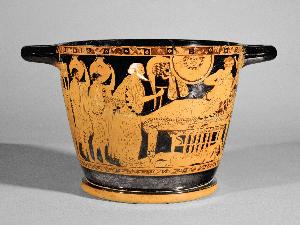Brygos Painter
Brygos;Brygos Painter
Biography:
The Brygos Painter was an ancient Greek Attic red-figure vase painter of the Late Archaic period. Together with Onesimos, Douris and Makron, he is among the most important cup painters of his time. He was active in the first third of the 5th century BCE, especially in the 480s and 470s BCE. He was a prolific artist to whom over two hundred vases have been attributed, but he is perhaps best known for the Brygos Cup, a red-figure kylix in the Louvre which depicts the 'iliupersis' or sack of Troy. The name Brygos Painter is derived from several cups painted in a distinctive style and bearing the signature 'Brygos'. This inscription, currently present on sixteen vessels (some complete pieces and some fragments), is often accompanied by the word epoiesen. This suggests that the name refers to the potter or maker, rather than the painter, whose name would likely be followed by the word egrapsen. Some scholars persist in believing that the Brygos designation suggests that the painter and potter are one and the same; however, this seems problematic given the presence of the signature on a handful of vessels that were not painted by the Brygos Painter, but rather were decorated by other contemporary artists. This would imply that indeed the name of Brygos most likely belongs to the potter who fashioned the matrices on which the unnamed painter created his masterpieces. More likely, there was a partnership in place that resulted in Brygos forming the vessels with the Brygos Painter providing the illustrations. Nevertheless, the name 'Brygos Painter' has been used by scholars since P. Hartwig as a means to outline a single master’s style and artistic production.

